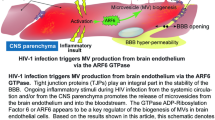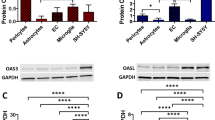Abstract
The infiltration of human immunodeficiency virus (HIV)-1, such as by HIV-infected leukocytes, across an injured blood-brain barrier (BBB) is a characteristic pathologic manifestation of HIV-1—associated dementia. HIV-1 gp120 has been implicated as a cause of breakdown of tight junctions between endothelial cells of the BBB, though the disrupting molecular mechanisms are unexplained. This study offers a new explanation for the increased BBB microvascular permeability, due to the degradation of tight junction proteins by the proteasome induced by gp120, and the negative regulation of this process by the scaffold protein, 14-3-3τ. gp120 reduced the amount of zonula occludens (ZO)-1 and ZO-2 in human brain microvascular endothelial cells (HBMECs). The treatment of HBMECs with the proteasome inhibitor, lactacystin, blocked the degradation of ZO-1 and ZO-2, suggesting that these proteins were targeted by gp120 for degradation by the proteasome. gp120 also specifically increased the expression of 14-3-3τ in HBMECs, and its down-regulation by RNAi facilitated the breakdown of tight junction proteins induced by gp120. Our results demonstrate the novel molecular mechanisms of the BBB breakdown by gp120.
Similar content being viewed by others
References
Aberle H, Bauer A, Stappert J, Kispert A, Kemler R (1997). β-Catenin is a target for the ubiquitin-proteasome pathway. EMBO J 16: 3797–3804.
Adle-Biassette H, Levy Y, Colombel M, Poron F, Natchev S, Keohane C, Gray F (1995). Neuronal apoptosis in HIV infection in adults. Neuropathol Appl Neurobiol 21: 218–227.
An SF, Giometto B, Scaravilli T, Tavolato B, Gray F, Scaravilli F (1996). Programmed cell death in brains of HIV-1-positive AIDS and pre-AIDS patients. Acta Neuropathol 91: 169–173.
Annunziata P, Cioni C, Toneatto S, Paccagnini E (1998). HIV-1 gp120 increases the permeability of rat brain endothelium cultures by a mechanisms involving substance P. AIDS 12: 2377–2385.
Arese M, Ferrandi C, Primo L, Camussi G, Bussolino F (2000). HIV-1 Tat protein stimulates in vivo vascular permeability and lymphomononuclear cell recruitment. J Immunol 166: 1380–1388.
Banks WA, Akerstrom V, Kastin AJ (1998). Adsorptive endocytosis mediates the passage of HIV-1 across the blood-brain barrier: evidence for a post-internalization coreceptor. J Cell Sci 111: 533–540.
Berg D, Holzmann C, Riess O (2003). 14-3-3 Proteins in the nervous system. Nat Rev Neurosci 4: 752–762.
Boston PF, Jackson P, Thompson RJ (1982). Human 14-3-3 protein: radioimmunoassay, tissue distribution, and cerebrospinal fluid levels in patients with neurological disorders. J Neurochem 38: 1475–1482.
Boven LA, Middel J, Verhoef J, DeGroot CJ, Nottet HS (2000). Monocyte infiltration is highly associated with loss of tight junction protein zonula occludens in HIV-1-associated dementia. Neuropathol Appl Neurobiol 26: 356–360.
Budka H (1991). Neuropathology of human immunodeficiency virus infection. Brain Pathol 1: 163–175.
Celine F, Tilloy-Ellul A, Chevalier S, Charuel C, Pointis G (2004). Sertoli cell junctional proteins as early targets for different classes of reproductive toxicants. Reprod Toxicol 18: 413–421.
Conklin DS, Galaktionov K, Bearch D (1995). 14-3-3 proteins associate with cdc2 5 phosphatases. Proc Natl Acad Sci U S A 92: 7892–7896.
Dallasta LM, Pisarov LA, Esplen JE, Werley JV, Moses AV, Nelson JA, Achim CL (1999). Blood-brain barrier tight junction disruption in HIV encephalitis. Am J Pathol 155: 1915–1927.
Everall IP, Luthert PJ, Lantos PL (1991). Neuronal loss in the frontal cortex in HIV infection. Lancet 337: 1119–1121.
Fanning AS, Jameson BJ, Jesaitis LA, Anderson JM (1998). The tight junction protein ZO-1 establishes a link between the transmembrane protein occludin and the actin cytoskeleton. J Biol Chem 273: 29745–29753.
Fink C, Weigel R, Hembes T, Lauke-Wettwer H, Kliesch S, Bergmann M, Brehm RH (2006). Altered expression of ZO-1 and ZO-2 in Sertoli cells and loss of blood-testis barrier integrity in testicular carcinoma in situ. Neoplasia 8: 1019–1027.
Fischer S, Wobben M, Marti HH, Renz D, Schaper W (2002). Hypoxia-induced hyperpermeability in brain microvessel endothelial cells involves VEGF-mediated changes in the expression of zonula occludens-1. Microvasc Res 63: 70–80.
Fu H, Xia K, Pallas DC, Cui C, Conroy K, Narsimhan RP, Mamon H, Collier RJ, Roberts TM (1994). Interaction of the protein kinase Raf-1 with 14-3-3 proteins. Science 266: 126–129.
Gardner TW, Lesher T, Khin S, VU C, Barber AJ, Brennan WA (1996). Histamine reduces ZO-1 tight-junction protein expression in cultured retinal microvascular endothelial cells. Biochem J 320: 717–721.
Helke KL, Queen SE, Tarwater PM, Turchan-Cholewo J, Nath A, Zink MC, Irani DN, Manknowski JL (2005). 14-3-3 Protein in CSF: an early predictor of SIV CNS disease. J Neuropathol Exp Neurol 64: 202–208.
Hsich G, Kenney K, Gibbs CJ, Lee KH, Harrington MG. (1996). The 14-3-3 brain protein in cerebrospinal fluid as a marker for transmissible spongiform encephalopathies. N Engl J Med 335: 24–30.
Kanmogne GD, Primeaux C, Grammas P (2005). HIV-1 gp120 proteins alter tight junction protein expression and brain endothelial cell permeability: implication for the pathogenesis of HIV-associated dementia. J Neuropathol Exp Neurol 64: 498–505.
Kanmogne GD, Schall K, Leibhart J, Knipe B, Gendelman HE, Persidsky Y (2007). HIV-1 gp120 compromises blood-brain barrier integrity and enhance monocyte migration across blood-brain barrier: implication for viral neuropathogenesis. J Cereb Blood Flow Metab 27: 123–134.
Kim TA, Avraham HK, Koh YH, Jiang S, Avraham S (2003). HIV-1 Tat-mediated apoptosis in human brain microvascular endothelial cells. J Immunol 170: 2629–2637.
Laing JG, Beyer EC (1995). The gap junction protein connexin43 is degraded via the ubiquitin proteasome pathway. J Biol Chem 270: 26399–26403.
Luabeya MK, Dallasta LM, Achim CL, Pauza CD, Hamilton RL (2000). Blood-brain barrier disruption in simian immunodeficiency virus encephalitis. Neuropathol Appl Neurobiol 26: 454–462.
Mark KS, Davis TP (2002). Cerebral microvascular changes in permeability and tight junctions induced by hypoxiareoxygenation. Am J Physiol Heart Circ Physiol 282: H1485-H1494.
Namikawa K, Su Q, Kiryu-Seo S, Kiyama H (1998). Enhanced expression of 14-3-3 family members in injured motoneurons. Mol Brain Res 55: 315–320.
Nottet HS, Persidsky Y, Sasseville VG, Nukuna AN, Bock P, Zhai QH, Sharer LR, McComb RD, Swindells S, Soderland C, Gendelman HE (1996). Mechanisms for the transendothelial migration of HIV-1-infected monocytes into brain. J Immunol 156: 1284–1295.
Obsil T, Ghirlando R, Klein DC, Ganguly S, Dyda F (2001). Crystal structure of the 14-3-3 zeta: serotonin N-acetyltransferase complex: a role for scaffolding in enzyme regulation. Cell 105: 257–267.
Oshima T, Flores SC, Vaitaitis G, Coe LL, Joh T, Park JH, Zhu Y, Alexander B, Alexander JS (2000). HIV-1 Tat increases endothelial solute permeability through tyrosine kinase and mitogen-activated protein kinase-dependent pathways. AIDS 14: 475–482.
Persidsky Y, Stins M, Way D, Witte MH, Weinand M, Kim KS, Bock P, Gendelman HE, Fiala M (1997). A model for monocyte migration through the blood-brain barrier during HIV-1 encephalitis. J Immunol 158: 3499–3510.
Petito CK, Robert B (1995). Evidence of apoptotic cell death in HIV encephalitis. Am J Pathol 146: 1121–1130.
Power C, Kong PA, Crawford TO, Wesselingh S, Glass JD, McArthur JC, Trapp BD (1993). Cerebral white matter changes in acquired immunodeficiency syndrome dementia: alternations of the blood-brain barrier. Ann Neurol 34: 339–350.
Price RW, Perry SW (1994). HIV, AIDS, and brain. New York: Raven Press.
Pu H, Tian J, Ibolya EA, Hayashi K, Flora G, Hennig B, Toborek M (2005). HIV-1 Tat protein-induced alternations of ZO-1 expression are mediated by redox-regulated ERK1/2 activation. J Cereb Blood Flow Metab 25: 1325–1335.
Reuther GW, Fu H, Cripe LD, Collier RJ, Pendergast AM (1994). Association of the protein kinase-c-Bcr and Bcr-Abl with proteins of the 14-3-3 family. Science 266: 129–133.
Rincon-Choles H, Vasylyeva TL, Pergola PE, Basant B, Bhandari K, Zhang JH, Wang W, Gorin Y, Barnes JL, Abboud HE (2006). ZO-1 expression and phosphorylation in diabetic nephropathy. Diabetes 55: 894–900.
Satoh J, Tabunoki H, Nanri Y, Arima K, Yamamura T (2006). Human astrocytes express 14-3-3 sigma in response to oxidative and DNA-damaging stresses. Neurosci Res 56: 61–72.
Suzuki A, Hirata M, Kamimura K, Maniwa R, Yamanaka T, Mizuno K, Kishikawa M, Hirose H, Amano Y, Izumi N, Miwa Y, Ohno S (2004). aPKC Acts Upstream of PAR-1b in both the establishment and maintenance of mammalian epithelial polarity. Curr Biol 14: 1425–1435.
Traweger A, Fang D, Liu YC, Stelzhammer W, Krizbai IA, Fresser F, Bauer HC, Bauer H (2002). The tight junction-specific protein occludin is a functional target of the E3 ubiquitin-protein ligase itch. J Biol Chem 277: 10201–10208
Tsukamoto T, Nigam SK (1999). Cell-cell dissociation upon epithelial cell scattering requires a step mediated by the proteasome. J Biol Chem 274: 24579–24584.
Tsukita S, Furuse M, Itoh M (1999). Structural and signaling molecules come together at tight junctions. Curr Opin Cell Biol 11: 628–633.
Wakabayashi H, Yano M, Tachikawa N, Oka S, Maeda M, Kido H (2001). Increased concentration of 14-3-3ε, γ and ζ isoforms in cerebrospinal fluid of AIDS patients with neuronal destruction. Clin Chim Acta 312: 97–105.
Wiley CA, Masliah E, Morey M, Lemere C, DeTeresa R, Grafe M, Hansen L, Terry R (1991). Neocortical damage during HIV infection. Ann. Neurol 29: 651–657.
Yano M, Nakamuta S, Shiota M, Endo H, Kido H (2007). Gatekeeper role of 14-3-3τ protein in HIV-1 gp120-mediated apoptosis of human endothelial cells by inactivation of Bad. AIDS 21: 911–920.
Yano M, Nakamuta S, Wu X, Okumura Y, Kido H (2006). A novel function of 14-3-3 protein: 14-3-3ζ is a heat-shock-related molecular chaperone that dissolves thermal-aggregated Proteins. Mol Biol Cell 17: 4769–4779.
Youakim A, Ahdieh M (1999). Interferon-γ decreases barrier function in T84 cells by reducing ZO-1 levels and disrupting apical actin. Am J Physiol 276: G1279-G1288.
Zerr I, Bodemer M, Gefeller O, Otto M, Poser S, Wiltfang J, Windl O, Kretzschmar HA, Weber T (2000). Detection of 14-3-3 protein in the cerebrospinal fluid supports the diagnosis of Creutzfeldt-Jakob disease. Ann Neurol 43: 683–684.
Zha J, Harada H, Yang E, Jockel J, Korsmeyer SJ (1996). Serine phosphorylation of death agonist BAD in response to survival factor results in binding to 14-3-3 not BCL-XL. Cell 87: 619–628.
Author information
Authors and Affiliations
Corresponding author
Additional information
Shinichi Nakamuta and Hiroshi Endo contributed equally to this work.d
This work was supported, in part, by a Grant-in-Aid (no. 205-01) from the Ministry of Health and Welfare, the Program for Promotion of Fundamental Studies in Health Science of NIBIO, and CLUSTER Project of MEXT.
Rights and permissions
About this article
Cite this article
Nakamuta, S., Endo, H., Higashi, Y. et al. Human immunodeficiency virus type 1 gp120-mediated disruption of tight junction proteins by induction of proteasome-mediated degradation of zonula occludens-1 and -2 in human brain microvascular endothelial cells. Journal of NeuroVirology 14, 186–195 (2008). https://doi.org/10.1080/13550280801993630
Received:
Revised:
Accepted:
Issue Date:
DOI: https://doi.org/10.1080/13550280801993630




